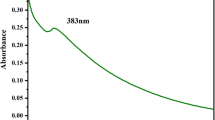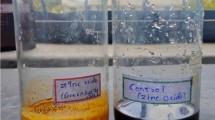Abstract
Satureja sahendica Bornm belongs to the mint family (Lamiaceae family) and is a native medicinal plant-specific to Iran. In addition to being used in the kitchen, this plant contains essential oils with major constituents of thymol, γ-terpinene, paracetamol, and carvacrol, which have medicinal uses. In the present study, the ethanolic extract of Satureja sahendica leaves was used for the biosynthesis of ZnO nanoparticles simply and cost-effectively. The biosynthesized nanoparticles, hereinafter referred to as SSE-ZnONPs, were characterized using UV–Vis spectroscopy, X-ray diffraction (XRD), scanning electron microscopy/energy-dispersive X-ray (SEM/EDX), transmission electron microscopy (TEM), Fourier transform infrared spectroscopy (FTIR), differential scanning calorimetry (DSC), and thermogravimetry analysis (TGA). The analysis of the results demonstrated the successful synthesis of SSE-ZnONPs by the reductive action of Satureja sahendica extract. The synthesized nanoparticles were found to be crystalline nanoscale structures with multi-dimensional round shape and particle size of 48 to 61 nm. UV–Vis analysis of the biosynthesized nanoparticles showed a characteristic spectral peak at 383 nm with a zeta potential value of − 40 mV. The minimum inhibitory concentration (MIC) and minimum bactericidal concentration (MBC) values of SSE-ZnONPs against gram-negative Escherichia coli, Pseudomonas aeruginosa, and Gram-positive bacteria Bacillus cereus, and Staphylococcus aureus were found to be 1250, 625, 625, and 2500 µg/ml and 1000, 5000, 2500, and 5000 µg/l, respectively. SSE-ZnONPs, with a concentration of 600 μg/ml, prevented up to 60% and 30% of biofilm formation by Pseudomonas aeruginosa and Staphylococcus aureus, respectively. Also, SSE-ZnONPs, at a concentration of 200 μg/ml, could inhibit the formation of Escherichia coli and Bacillus cereus biofilms by up to 30% and 31%, respectively. The results showed that SSE-ZnONPs impede the exopolysaccharide (EPS) formation of the tested bacterial strains. Overall, the green synthesized SSE-ZnONPs have been shown to have antimicrobial and antibiofilm activities that could be used as a promising candidate for controlling pathogenic microorganisms.






Similar content being viewed by others
References
Hamidpour R, Hamidpour S, Hamidpour M, Shahlari M, Sohraby M (2014) Summer Savory: from the selection of traditional applications to the novel effect in relief, prevention, and treatment of a number of serious illnesses such as diabetes, cardiovascular disease, alzheimer’s disease, and cancer. J Tradit Complement Med 4:140–144. https://doi.org/10.4103/2225-4110.136540
Sadia A, Isfahan T, Fazli S, Nighat S, Ibrar K, Umair A, Kashif SH (2020) An overview of the plant-mediated synthesis of zinc oxide nanoparticles and their antimicrobial potential. Inorganic Nano-Metal Chem 50:257–271. https://doi.org/10.1080/24701556.2019.1711121
Momtaz S, Abdollahi M (2010) An update on pharmacology of Satureja species: from antioxidant, antimicrobial, antidiabetes and anti-hyperlipidemic to reproductive stimulation. Int J Pharmacol 6:454–461. https://doi.org/10.3923/ijp.2010.346.353
lashin I, Hasanin M, Hassan SAM, Hashem AH (2021) Green biosynthesis of zinc and selenium oxide nanoparticles using callus extract of Ziziphus spina-christi: characterization, antimicrobial, and antioxidant activity. Biomass Conv Bioref https://doi.org/10.1007/s13399-021-01873-4
Parvin A, Sajjad S (2016) Bio-Synthesis of silver nanoparticles using water extract of Satureja hortensis L and evaluation of the antibacterial properties. Curr Nanosci 12:90–93. https://doi.org/10.2174/1573413711666150529202238
Salem SS, Fouda A (2021) Green synthesis of metallic nanoparticles and their prospective biotechnological applications: an overview. Biol Trace Elem Res 199:344–370. https://doi.org/10.1007/s12011-020-02138-3
Mitevska E, Wang B, Surewaard BGJ, Jenne CN (2021) Pathogens The prevalence, risk, and management of methicillin-resistant Staphylococcus aureus infection in diverse populations across Canada: a systematic review. Pathogens 10:393. https://doi.org/10.3390/pathogens10040393
Vogelaers D, Blot S, Van den Berge A (2021) Antimicrobial lessons from a large observational cohort on intra-abdominal infections in intensive care units. Drugs 81:1065–1078. https://doi.org/10.1007/s40265-021-01534-w
Naseer M, Aslam U, Khalid B, Chen B (2020) Green route to synthesize zinc oxide nanoparticles using leaf extracts of Cassia fstula and Melia azadarach and their antibacterial potential. Sci Rep 10:1–10. https://doi.org/10.1038/s41598-020-65949-3
Mohamed AA, Abu-Elghait M, Ahmed NE, Salem SS (2020) Eco-friendly mycogenic synthesis of ZnO and CuO nanoparticles for in vitro antibacterial, antibiofilm, and antifungal applications. Biol Trace Elem Res 197(7):2788–2799. https://doi.org/10.1007/s12011-020-02369-4
Zgorka G, Glowniak K (2001) Variation of free phenolic acids in medicinal plants belonging to Lamiaceae family. J Pharm Biomed Anal 26:79–87. https://doi.org/10.1016/s0731-7085(01)00354-5
Grasso G, Dniela Z, Dragone R (2021) Microbial nanotechnology: challenges and prospects for green biocatalytic synthesis of nanoscale materials for sensoristic and biomedical applications. Nanomaterial 10:11. https://doi.org/10.3390/nano10010011
Vinardell MP, Llanas H, Marics L, Mitjans M (2017) In vitro comparative skin irritation induced by nano and non-nano zinc oxide. Nanomaterial 7:56. https://doi.org/10.3390/nano7030056
Chkhikvishvili I, Sanikidze T, Gogia N, McHedlishvili T, Enukidze M, Machavariani M, Vinokur Y, Rodov V (2013) Rosmarinic acid-rich extracts of summer savory (Satureja hortensis. L) protect Jurkat T cells against oxidative stress. Oxid Med Cell 456253 https://doi.org/10.1155/2013/456253.
Davaeifar S, Modarresi MH, Mohammadi M, Hashemi E, Shafiei M, Maleki H, Vali H, Zahiri HS, Noghabi KA (2019) Synthesizing, characterizing, and toxicity evaluating of Phycocyanin-ZnO nanorod composites: a back to nature approaches. Colloids Surf B: Biointerfaces 175:221–230. https://doi.org/10.1016/j.colsurfb.2018.12.002
Ali K, Dwivedi S, Azam A, Saquib Q, Al-Said MS, Alkhedhairy AA, Musarrat J (2016) Aloe vera extract functionalized zinc oxide nanoparticles as nanoantibiotics against multi-drug resistant clinical bacterial isolates. J Colloid Interface Sci 472:145–156. https://doi.org/10.1016/j.jcis.2016.03.021
Pillai AM, Sivasankarapillai VS, Rahdar A, Joseph J, Sadeghfar F, Anuf RA, Rajesh K, Kyzas GZ (2020) Green synthesis and characterization of zinc oxide nanoparticles with antibacterial and antifungal activity. J Mol Struct 1211:128107. https://doi.org/10.1016/j.molstruc.2020.128107
Khan ST, Ahamed M, Alhadlaq HAM, J, Al-Khedhairy A, (2013) Comparative effectiveness of NiCl2, Ni- and NiO-NPs in controlling oral bacterial growth and biofilm formation on oral surfaces. Arch Oral Biol 58:1804–1811. https://doi.org/10.1016/j.archoralbio.2013.09.011
Ebadi M, Zolfaghari MR, Aghaei SS, Zargar M, Noghabi KA (2021) Desertifilum sp. EAZ03 cell extract as a novel natural source for the biosynthesis of zinc oxide nanoparticles and antibacterial, anticancer and antibiofilm characteristics of synthesized zinc oxide nanoparticles. J Appl Microbiol https://doi.org/10.1111/jam.15177.
Dwivedi S, Wahab R, Khan F, Mishra YK, Musarrat J, Al-Khedhairy AA (2014) Reactive oxygen species mediated bacterial biofilm inhibition via zinc oxide nanoparticles and their statistical determination. PloS One 9:e111289 https://doi.org/10.1371/journal.pone.0111289
Sangeetha G, Rajeshwari S, Venckatesh R (2011) Green synthesis of zinc oxide nanoparticles by aloe barbadensis miller leaf extract: structure and optical properties. Mater Res Bull 46(12):2560–2566. https://doi.org/10.1016/j.materresbull.2011.07.046
Mukha I, Eremenko A, Korchak G, Michienkova A (2010) Antibacterial action and physicochemical properties of stabilized silver and gold nanostructures on the surface of disperse silica. J Water Res Protec 2:131–136. https://doi.org/10.4236/jwarp.2010.22015
Sefidkon F, Jamzad Z, Mirza M (2004) Chemical variation in the essential oil of Satureja sahendica from Iran. Food Chem 88:325–328. https://doi.org/10.1016/j.foodchem.2003.12.044
Khalil MMH, Ismail EH, El-Baghdady KZ, Mohamed D (2014) Green synthesis of silver nanoparticles using olive leaf extract and its antibacterial activity. Arab J Chem 7:1131–1139. https://doi.org/10.1016/j.arabjc.2013.04.007
Fakhari S, Jamzad M, Kabiri Fard H (2019) Green synthesis of zinc oxide nanoparticles: a comparison. Green Chem Lett Rev 12:19–24. https://doi.org/10.1080/17518253.2018.1547925
Shim YJ, Soshnikova V, Anandapadmanaban G, Mathiyalagan R, Jimenez Perez ZE, Markus J, Ju Kim Y, Castro-Aceituno V, Yang DC (2019) Zinc oxide nanoparticles synthesized by Suaeda japonica Makino and their photocatalytic degradation of methylene blue. Optik 182:1015–1020. https://doi.org/10.1016/j.ijleo.2018.11.144
Anandan M, Poorani G, Boomi DP, Varunkumar K, Anand K, Chuturgoon A, Saravanan M, Gurumallesh-Prabu H (2019) Green synthesis of anisotropic silver nanoparticles from the aqueous leaf extract of Dodonaea viscosa with their antibacterial and anticancer activities. Process Biochem 80:80–88. https://doi.org/10.1016/j.procbio.2019.02.014
Alamdari S, Sasani-Ghamsari M, Lee C, Han W, Park H-H, Tafreshi MJ, Afarideh H, Ara MH (2020) Preparation and characterization of zinc oxide nanoparticles using leaf extract of Sambucus ebulus. Appl Sci 10(10):3620
Azam A, Ahmed AS, Oves M, Khan MS, Habib SS, Memic A (2012) Antimicrobial activity of metal oxide nanoparticles against gram-positive and gram-negative bacteria: a comparative study. Int J Nanomedicine 7:6003–6009. https://doi.org/10.2147/IJN.S35347
Qayyum S, Oves M, Khan AU (2012) Obliteration of bacterial growth and biofilm through ROS generation by facilely synthesized green silver nanoparticle. PLoS ONE 12:e0181363–e0181363. https://doi.org/10.1371/journal.pone.0181363
Ahmar Rauf M, Oves M, Ur Rehman F, Rauf Khan A, Husain N (2019) Bougainvillea flower extract mediated zinc oxide’s nanomaterials for antimicrobial and anticancer activity. Biomed Pharmacother 116:108983. https://doi.org/10.1016/j.biopha.2019.108983
Dogan SS, Kocabas A (2019) Green synthesis of ZnO nanoparticles with Veronica multifida and their antibiofilm activity. Hum Exp Toxicol 39:319–327. https://doi.org/10.1177/0960327119888270
Rajivgandhi G, Ramachandran G, Maruthupandy M, Vaseeharan B, Manoharan N (2019) Molecular identification and structural characterization of marine endophytic actinomycetes Nocardiopsis sp. GRG 2 (KT 235641) and its antibacterial efficacy against isolated ESBL producing bacteria. Microbial Pathogen 126:138–148. https://doi.org/10.1016/j.micpath.2018.10.014
Muthuchamy M, Govindan R, Shine K, Thangasamy V, Alharbi NS, Thillaichidambaram M, Khaled JM, Wen JL, Alanzi KF (2020) Anti-biofilm investigation of graphene/chitosan nanocomposites against biofilm producing P. aeruginosa and K. pneumoniae. Carbohydr Polymers 230:115646. https://doi.org/10.1016/j.carbpol.2019.115646
Rajivgandhi GN, Ramachandran G, Maruthupandy M, Manoharan N, Alharbi NS, Kadaikunnan S, Khaled JM, Almanaa TN, Li WJ (2020) Anti-oxidant, anti-bacterial and anti-biofilm activity of biosynthesized silver nanoparticles using Gracilaria corticata against biofilm producing K. pneumoniae. Colloids Surf A Physico Chem Eng Asp 600:124830.https://doi.org/10.1016/j.colsurfa.2020.124830.
Zhong L, Liu H, Samal M, Yun K (2018) Synthesis of ZnO nanoparticles-decorated spindle-shaped graphene oxide for application in synergistic antibacterial activity. J Photochem Photobiol B 183:293–301. https://doi.org/10.1016/j.jphotobiol.2018.04.048
Rafiee B, Ghani S, Sadeghi D, Ahsani M (2018) Green synthesis of zinc oxide nanoparticles using Eucalyptus melliodora leaf extract and Evaluation of its antimicrobial effects. J Babol Univ Med Sci 1:28–35. https://doi.org/10.18869/acadpub.jbums.20.10.28
Umar H, Kavaz D, Rizaner N (2018) Biosynthesis of zinc oxide nanoparticles using Albizia lebbeck stem bark, and evaluation of its antimicrobial, antioxidant, and cytotoxic activities on human breast cancer cell lines. Int J Nanomedicine 14:87–100. https://doi.org/10.2147/IJN.S186888
Dobrucka R, Długaszewska J (2018) Biosynthesis and antibacterial activity of ZnO nanoparticles using Trifolium pratense flower extract. Saudi J Biol Sci 23:517–523. https://doi.org/10.1016/j.sjbs.2015.05.016
Gunalan S, Sivaraj R, Rajendran V (2012) Green synthesized ZnO nanoparticles against bacterial and fungal pathogens. Prog Nat Sci 22:693–700. https://doi.org/10.1016/j.pnsc.2012.11.015
Mohammadi-Arvanag F, Bayrami A, Habibi-Yangjeh A, Rahim-Pouran S (2019) A comprehensive study on antidiabetic and antibacterial activities of ZnO nanoparticles biosynthesized using Silybum marianum L seed extract. Mater Sci Eng C 97:397–405. https://doi.org/10.1016/j.msec.2018.12.058
Author information
Authors and Affiliations
Contributions
K.A.N. conceptualized and developed the main idea; V.C, and M.E. performed the experiments; K.A.N., K.P.A, and K.A.N analyzed the overall results; K.A.N. analyzed and interpreted all the data and wrote the manuscript. All the authors have seen and approved the final version of manuscript.
Corresponding authors
Ethics declarations
Conflict of interest
The authors declare no competing interests.
Additional information
Publisher's note
Springer Nature remains neutral with regard to jurisdictional claims in published maps and institutional affiliations.
Rights and permissions
About this article
Cite this article
Chegini, V., Noghabi, K.A., Afshari, K.P. et al. Biological synthesis of ZnO nanoparticles using ethanolic extract of Satureja sahendica Bornm: its characterization and antimicrobial features. Biomass Conv. Bioref. 13, 16037–16048 (2023). https://doi.org/10.1007/s13399-021-02187-1
Received:
Revised:
Accepted:
Published:
Issue Date:
DOI: https://doi.org/10.1007/s13399-021-02187-1




